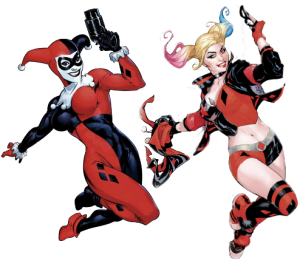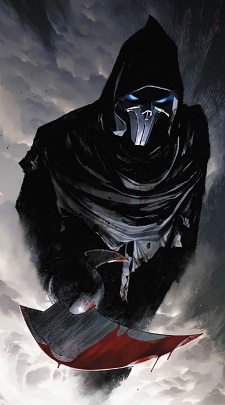
Poison Ivy, also known simply as Ivy, is a fictional character appearing in American comic books published by DC Comics, commonly in Batman stories. She was created by Robert Kanigher and Carmine Infantino, and first appeared in Batman #181.

Harley Quinn is a character appearing in American comic books published by DC Comics. She was created by Paul Dini and Bruce Timm for Batman: The Animated Series as a henchwoman for the Joker, and debuted in its 22nd episode, "Joker's Favor", on September 11, 1992. While intended to appear in one episode, Quinn became a recurring character within the DC Animated Universe (DCAU) as the Joker's sidekick and love interest, and was adapted into DC Comics' canon seven years later, beginning with the one-shot Batman: Harley Quinn #1. Quinn's origin story features her as a former psychologist at Gotham City's Arkham Asylum who was manipulated by and fell in love with the Joker, her patient, eventually becoming his accomplice and lover. The character's alias is a play on the stock character Harlequin from the 16th-century Italian theater commedia dell'arte.

Man-Bat is a fictional character appearing in American comic books published by DC Comics. Introduced in Detective Comics #400 as an enemy of the superhero Batman, the character belongs to the collective of adversaries that make up his rogues gallery. Originally portrayed as a supervillain, later incarnations show the Man-Bat as a sympathetic villain or antihero.

The Batman Adventures is a DC Comics comic book series featuring Batman. It is different from other Batman titles because it is set in the continuity of Batman: The Animated Series, as opposed to the regular DC Universe.

The Mad Hatter is a supervillain appearing in comic books published by DC Comics, commonly as an adversary of the superhero Batman. He is modeled after the Hatter from Lewis Carroll's novel Alice's Adventures in Wonderland, a character often called the "Mad Hatter" in adaptations of Carroll. A scientist who invents and uses technological mind control devices to influence and manipulate the minds of his victims, the Mad Hatter is one of Batman's most enduring enemies and belongs to the collective of adversaries that make up Batman's rogues gallery.

The New Adventures of Batman is an animated series that aired on CBS from February 12 to May 28, 1977, featuring the DC Comics superheroes Batman and Robin, and Batgirl. The series was a Filmation and DC Comics production in association with Warner Bros. Television.

The Ventriloquist is the name of multiple supervillains appearing in American comic books and other media published by DC Comics. All of the Ventriloquist's versions are enemies of Batman, belonging to the collective of adversaries that make up Batman's rogues gallery.

The DC Animated Universe is an American media franchise and shared universe centered on a group of animated television series based on DC Comics and produced by Warner Bros. Animation. It began with Batman: The Animated Series in 1992 and ended with Justice League Unlimited in 2006. Animated feature films and shorts, comic books, video games, and other multimedia adaptations are also in the continuity that continued to be released years later.

Firefly is a supervillain appearing in American comic books published by DC Comics. Created by France Herron and Dick Sprang, he made his debut in Detective Comics #184. Initially portrayed as a criminal who utilized lighting effects to commit robberies, Firefly was later reimagined as a sociopathic pyromaniac with an obsessive compulsion to start fires following Crisis on Infinite Earths' reboot of the DC Universe in the 1980s. This darker depiction of the character has since endured as one of the superhero Batman's most recurring enemies and belongs to the collective of adversaries that make up his central rogues gallery.

Livewire is a supervillainess appearing in multimedia produced by DC Entertainment, and American comic books published by DC Comics. Created for Superman: The Animated Series, the character appeared in March 1997 in Superman Adventures #5. Her first mainstream comic book appearance was in DC Comics' Action Comics #835.

The New Batman Adventures is an American animated superhero television series based on the DC Comics superhero Batman, which aired on Kids' WB from September 13, 1997 to January 16, 1999. Produced by Warner Bros. Animation, it is a continuation of Batman: The Animated Series (1992–1995), serving as the third season of the show and the third series in the DC Animated Universe. It was followed by Batman Beyond (1999–2001). The series had a revamp, replacing the previous art style of its predecessor with streamlined designs for more consistent animation, and to maintain similarity with the simultaneously running Superman: The Animated Series (1996–2000), with episodes airing on Kids' WB under the title The New Batman/Superman Adventures.

Andrea Beaumont, also known as the Phantasm, is a fictional DC Comics supervillain and antiheroine created by Alan Burnett and Paul Dini, and designed by Bruce Timm. Beaumont first appeared as the one of the main antagonists, along with the Joker, in the 1993 DC Animated Universe (DCAU) film Batman: Mask of the Phantasm, where she was established as the girlfriend of Bruce Wayne/Batman prior to and around the time he first began his vigilante career. Dana Delany provided the voice work for Andrea and Stacy Keach provided the electronically modified voice of her "Phantasm" alter ego; Keach also provided the voice of Andrea's father, Carl.
Originally created in 1967, the fictional comic book character Barbara Gordon has been adapted into various other forms of media. The character has appeared in both live action and animated television series and films, as well as in video games in her alter-egos as both Batgirl and Oracle.

The Riddler, a supervillain in DC Comics and an adversary of the superhero Batman, has been adapted into numerous forms of media, including feature films, television series, and video games. The character has been portrayed in live-action by Frank Gorshin and John Astin in the 1960s television series Batman, Jim Carrey in the 1995 film Batman Forever, Cory Michael Smith in the 2014 Fox series Gotham, and Paul Dano in the 2022 film The Batman. Actors who have voiced the Riddler include John Glover in the DC animated universe, Robert Englund in The Batman, and Wally Wingert in the Batman: Arkham video games.

The character Two-Face was created by Bob Kane and first appeared in Detective Comics #66. However, he did not appear outside comics until half a century later in Batman: The Animated Series. Two-Face has since been substantially adapted from the comics into various forms of media, such as feature films, television series and video games. Two-Face has been voiced by Richard Moll in the DC Animated Universe, Troy Baker in the Batman: Arkham series, Billy Dee Williams in The Lego Batman Movie, and William Shatner in Batman vs. Two-Face. His live-action portrayals include Billy Dee Williams in Batman (1989), Tommy Lee Jones in Batman Forever, Aaron Eckhart in The Dark Knight, and Nicholas D'Agosto in the television series Gotham. In 2009, Two-Face was ranked #12 on IGN's list of the Top 100 Comic Book Villains of All Time.

The fictional supervillain Penguin, created by Bob Kane and Bill Finger, made his first appearance in Detective Comics #58. Since then, he has been adapted into other forms of media, including feature films, television series, and video games.

Batman: The Adventures Continue is a DC Comics comic book series starring Batman set in the world of the DC Animated Universe. It is a continuation of Batman: The Animated Series and its follow-up The New Batman Adventures. The book is co-written by Paul Dini and Alan Burnett, producers of the original animated television series, and illustrated by Ty Templeton, who also worked on previous comics inspired by Batman: TAS. The limited series was initially released as a "digital first" comic, beginning in April 2020. The first print issue, which collects the first two digital chapters, reached stores on June 10, 2020. The miniseries was extended from six to seven print issues, and later to eight. In March 2021, DC announced Season II of the series, with Issue 1 published in June 2021. As of June 2021, DC has planned seven issues for Season II. Season III, the final season of the comic, began publication on January 10, 2023.

Mr. Freeze was originally a comic book character and Batman's adversary, but has been substantially adapted from the comics into various forms of media, including feature films, television series, and video games. The character has been portrayed in live-action by George Sanders, Otto Preminger, and Eli Wallach in the Batman television series; by Arnold Schwarzenegger in the 1997 film Batman & Robin; and by Nathan Darrow on the Fox crime series Gotham. He has also been voiced by Michael Ansara in the DC Animated Universe and Maurice LaMarche in the Batman: Arkham video game franchise.
















